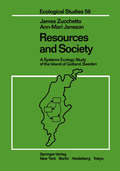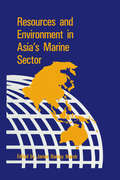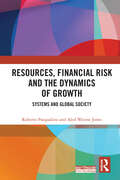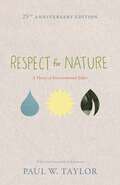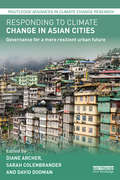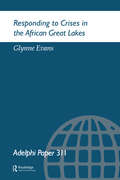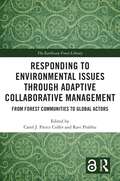- Table View
- List View
Resource Management and Contested Territories in East Asia
by R. EmmersRalf Emmers discusses the significance of natural resources as a source of inter-state cooperation and competition in East Asia, assessing whether the joint exploration and development of resources can act as a means to reduce tensions in contested territories. Does the joint management of natural resources in the absence of a negotiated maritime delimitation constitute a feasible strategy to de-escalate maritime sovereignty disputes in East Asia? Can cooperative resource exploitation be separated from nationalist considerations and power politics calculations? Alternatively, should the prospect for joint exploration in disputed waters be expected to raise rather than defuse territorial conflicts, especially if abundant resources are eventually discovered? If this were true, should exploration schemes be postponed until sovereignty disputes have been resolved? Emmers addresses these questions by examining the overlapping sovereignty claims in the Sea of Japan and the East and South China Seas.
Resource Management in Rice Systems: Papers presented at the International Workshop on Natural Resource Management in Rice Systems: Technology Adaption for Efficient Nutrient Use, Bogor, Indonesia, 2–5 December 1996 (Developments in Plant and Soil Sciences #81)
by V. Balasubramanian J. K. Ladha G. L. DenningRice is the major staple food in Asia, and food security means rice security for most Asians. By the year 2025, we need to produce about 60% more rice than we do today to meet the growing demand. Efficient use of inputs is vital to safely produce the additional food from limited resources with minimal impact on the environment. This book reviews emerging knowledge-intensive technologies and decision aids for improved nutrient management in rice, technology adoption constraints at the farm level, and innovative approaches for field evaluation and promotion of new technologies to farmers. It is highly useful to rice scientists and development workers, students of agronomy, soil science, and plant nutrition, and crop consultants and extension workers in rice all over the world.
Resource Management, Sustainable Development and Governance: Indian and International Perspectives (Sustainable Development Goals Series)
by Rajiv R. Thakur Baleshwar Thakur Srikumar Chattopadhyay Rajesh K. AbhayThis book examines the relationship between natural resource management, sustainable development, and governance with case studies from India and other places covering disaster risk reduction, conflict resolution, capacity building, climate change adaptation and resilience, citizen engagement and ecological conservation. Though the studies focus mostly on cases in India, the volume discusses how governance can be employed to help develop and implement sustainable practices globally through the lens of the United Nations Sustainable Development Goals (SDGs) framework. Readers will learn how to integrate concepts of resource management, sustainable development, and governance to improve human resilience to global environmental change, and to assess the proper development approaches to assist economically stressed and resource-deprived individuals. The book will be of use to graduate students and academics, policy makers, planners, and nonprofits.
Resource Peripheries in the Global Economy: Networks, Scales, and Places of Extraction (Economic Geography)
by Felipe Irarrázaval Martín Arias-LoyolaThis book discusses the conditions that underpin configuration of specific places as resource peripheries and the consequences that such a socio-spatial formation involves for those places. The book thereby provides an interdisciplinary approach underpinned by economic geography, political ecology, resource geography, development studies and political geography. It also discusses the different technological, political and economic changes that make the ongoing production of resource peripheries a distinctive socio-spatial formation under the global economy. Through a global and interdisciplinary perspective that uncovers ongoing political processes, socio-economic changes and socio-ecological dynamics at resource peripheries, this book argues that it is critical to take a more profound appraisal about the socio-spatial processes behind the contemporary way in which capitalism is appropriating and transforming nature.
Resources and Society: A Systems Ecology Study of the Island of Gotland, Sweden (Ecological Studies #56)
by James Zucchetto Ann-Mari JanssonAlthough this book is about a specific area of the world (i.e., Gotland, Sweden), the interdisciplinary nature of the study, with regard to resources, environment, and society, makes it of interest to a number of fields. We have tried to make this book readable for a wide variety of interested parties including systems ecologists, environmental scientists, resource economists, geographers, regional planners, and regional scientists, as well as those interested in Nordic conditions. Since this project was part of UNESCO's Man and the Biosphere (MAB) pro gram, this book should be of general interest to the international community. This book is certainly not a textbook, but we see it as being useful for courses in regional analysis with plenty of examples for illustrating analysis and models related to energy, environment, and economics, or to the general field of systems ecology. An instructor could, of course, supplement the material on systems and models with other sources. We hope this small book will serve as a helpful example of the analysis of the complex interdisciplinary problems associated with resources and society. In Chapter 1, we present a brief introduction to the Gotland study as well as to some of the concepts and theories that have guided our investigations.
Resources & Environment in Asia's Marine Sector
by James B. MarshThis volume brings together a cross-section of marine experts who provide a comprehensive exploration of the major facets of Asia's marine sector. It considers both the marine mineral and fish stocks in Asian waters. This extensive volume examines "official" statistics with an objective eye and provides an overview of fish stock with much focus on the access and management of tuna. It considers global economic issues concerning fishing rights, looks at joint ventures between nations, and considers law enforcement efforts. The volume devotes a section to sea lanes and another to off shore mineral deposits. It also considers current and growing problems and possible solutions regarding pollution.
Resources & Environment in Asia's Marine Sector
by James B. MarshThis volume brings together a cross-section of marine experts who provide a comprehensive exploration of the major facets of Asia's marine sector. It considers both the marine mineral and fish stocks in Asian waters. This extensive volume examines "official" statistics with an objective eye and provides an overview of fish stock with much focus on the access and management of tuna. It considers global economic issues concerning fishing rights, looks at joint ventures between nations, and considers law enforcement efforts. The volume devotes a section to sea lanes and another to off shore mineral deposits. It also considers current and growing problems and possible solutions regarding pollution.
Resources, Financial Risk and the Dynamics of Growth: Systems and Global Society
by Roberto Pasqualino Aled Wynne JonesThis book presents a new System Dynamics model (the ERRE model), a novel stock and flow consistent global impact assessment model designed by the authors to address the financial risks emerging from the interaction between economic growth and environmental limits under the presence of shocks. Building on the World3-03 Limits to Growth model, the ERRE links the financial system with the energy, agriculture and climate systems through the real economy, by means of feedback loops, time lags and non-linear rationally bounded decision making. Prices and their interaction with growth, inflation and interest rates are assumed to be the main driver of economic failure while reaching planetary limits. The model allows for the stress-testing of fat tail extreme risk scenarios, such as climate shocks, energy transition, monetary policies and carbon taxes. Risks are addressed via scenario analyses, compared to real available data, and assessed in terms of the economic theory that lies behind. The book outlines the case for a government led system change within this decade, where the market alone cannot lead to sustainable prosperity. This book will be of great interest to scholars of climate change, behavioural, ecological and evolutionary economics, green finance, and sustainable development.
Resources, Financial Risk and the Dynamics of Growth: Systems and Global Society
by Roberto Pasqualino Aled Wynne JonesThis book presents a new System Dynamics model (the ERRE model), a novel stock and flow consistent global impact assessment model designed by the authors to address the financial risks emerging from the interaction between economic growth and environmental limits under the presence of shocks. Building on the World3-03 Limits to Growth model, the ERRE links the financial system with the energy, agriculture and climate systems through the real economy, by means of feedback loops, time lags and non-linear rationally bounded decision making. Prices and their interaction with growth, inflation and interest rates are assumed to be the main driver of economic failure while reaching planetary limits. The model allows for the stress-testing of fat tail extreme risk scenarios, such as climate shocks, energy transition, monetary policies and carbon taxes. Risks are addressed via scenario analyses, compared to real available data, and assessed in terms of the economic theory that lies behind. The book outlines the case for a government led system change within this decade, where the market alone cannot lead to sustainable prosperity. This book will be of great interest to scholars of climate change, behavioural, ecological and evolutionary economics, green finance, and sustainable development.
Respect for Nature: A Theory of Environmental Ethics
by Paul W. TaylorWhat rational justification is there for conceiving of all living things as possessing inherent worth? In Respect for Nature, Paul Taylor draws on biology, moral philosophy, and environmental science to defend a biocentric environmental ethic in which all life has value. Without making claims for the moral rights of plants and animals, he offers a reasoned alternative to the prevailing anthropocentric view--that the natural environment and its wildlife are valued only as objects for human use or enjoyment. Respect for Nature provides both a full account of the biological conditions for life--human or otherwise--and a comprehensive view of the complex relationship between human beings and the whole of nature. This classic book remains a valuable resource for philosophers, biologists, and environmentalists alike--along with all those who care about the future of life on Earth. A new foreword by Dale Jamieson looks at how the original 1986 edition of Respect for Nature has shaped the study of environmental ethics, and shows why the work remains relevant to debates today.
Respect for Nature: A Theory of Environmental Ethics
by Paul W. TaylorWhat rational justification is there for conceiving of all living things as possessing inherent worth? In Respect for Nature, Paul Taylor draws on biology, moral philosophy, and environmental science to defend a biocentric environmental ethic in which all life has value. Without making claims for the moral rights of plants and animals, he offers a reasoned alternative to the prevailing anthropocentric view--that the natural environment and its wildlife are valued only as objects for human use or enjoyment. Respect for Nature provides both a full account of the biological conditions for life--human or otherwise--and a comprehensive view of the complex relationship between human beings and the whole of nature. This classic book remains a valuable resource for philosophers, biologists, and environmentalists alike--along with all those who care about the future of life on Earth. A new foreword by Dale Jamieson looks at how the original 1986 edition of Respect for Nature has shaped the study of environmental ethics, and shows why the work remains relevant to debates today.
Respiration in Archaea and Bacteria: Diversity of Prokaryotic Respiratory Systems (Advances in Photosynthesis and Respiration #16)
by Davide ZannoniThe book summarizes the achievements of the past decade in the biochemistry, bioenergetics, structural and molecular biology of respiratory processes in selected genera of the domain Bacteria along with an extensive coverage of the redox chains of extremophiles belonging to the Archaean domain. The volume is a unique piece of work since it contains a series of chapters dealing with metabolic features having important microbiological and ecological relevance such as the use of ammonium, iron, methane, sulfur and hydrogen as respiratory substrates or nitrous compounds in denitrification processes. Particular attention is also dedicated to peculiar groups of prokaryotes such as Gram positives, acetic acid bacteria, pathogens of the genera Helicobacter and Campylobacter, nitrogen fixing symbionts and free-living species, oxygenic phototrophs (Cyanobacteria) and anoxygenic (purple non-sulfur) phototrophs. The book is intended to be a long-term source of information for Ph.D. students, researchers and undergraduates from disciplines such as microbiology, biochemistry and ecology, studying basic and applied sciences, medicine and agriculture.
Responding to Climate Change in Asian Cities: Governance for a more resilient urban future (Routledge Advances in Climate Change Research)
by Diane Archer Sarah Colenbrander David DodmanThe role of cities in addressing climate change is increasingly recognised in international arenas, including the Sustainable Development Goals, the UN Framework Convention on Climate Change, and the New Urban Agenda. Asia is home to many of the countries that are most vulnerable to climate change impacts and, along with Africa, will be the site of most urban population growth over the coming decades. Bringing together a range of city experiences, Responding to Climate Change in Asian Cities provides valuable insights into how cities can overcome some of the barriers to building climate resilience, including addressing the needs of vulnerable populations. The chapters are centred on an overarching understanding that adaptive urban governance is necessary for climate resilience. This requires engaging with different actors to take into account their experiences, vulnerabilities and priorities; building knowledge, including collecting and using appropriate evidence; and understanding the institutions shaping interactions between actors, from the national to the local level. The chapters draw on a mix of research methodologies, demonstrating the variety of approaches to understanding and building urban resilience that can be applied in urban settings. Bringing together a range of expert contributors, this book will be of great interest to scholars of urban studies, sustainability and environmental studies, development studies and Asian studies.
Responding to Climate Change in Asian Cities: Governance for a more resilient urban future (Routledge Advances in Climate Change Research)
by Diane Archer Sarah Colenbrander David DodmanThe role of cities in addressing climate change is increasingly recognised in international arenas, including the Sustainable Development Goals, the UN Framework Convention on Climate Change, and the New Urban Agenda. Asia is home to many of the countries that are most vulnerable to climate change impacts and, along with Africa, will be the site of most urban population growth over the coming decades. Bringing together a range of city experiences, Responding to Climate Change in Asian Cities provides valuable insights into how cities can overcome some of the barriers to building climate resilience, including addressing the needs of vulnerable populations. The chapters are centred on an overarching understanding that adaptive urban governance is necessary for climate resilience. This requires engaging with different actors to take into account their experiences, vulnerabilities and priorities; building knowledge, including collecting and using appropriate evidence; and understanding the institutions shaping interactions between actors, from the national to the local level. The chapters draw on a mix of research methodologies, demonstrating the variety of approaches to understanding and building urban resilience that can be applied in urban settings. Bringing together a range of expert contributors, this book will be of great interest to scholars of urban studies, sustainability and environmental studies, development studies and Asian studies.
Responding to Crises in the African Great Lakes (Adelphi series)
by G. EvansExamines the international responses to the ethnic conflicts in Burundi and Rwanda from 1993-1997 and their overspill into Zaire. Concludes that the external reaction was impotent and incoherent, and urges a number of changes in response by the international community.
Responding to Crises in the African Great Lakes (Adelphi series)
by G. EvansExamines the international responses to the ethnic conflicts in Burundi and Rwanda from 1993-1997 and their overspill into Zaire. Concludes that the external reaction was impotent and incoherent, and urges a number of changes in response by the international community.
Responding to Environmental Issues through Adaptive Collaborative Management: From Forest Communities to Global Actors (The Earthscan Forest Library)
by Carol J. Pierce Colfer Ravi PrabhuFocused on forest management and governance, this book examines two decades of experience with Adaptive Collaborative Management (ACM), assessing both its uses and improvements needed to address global environmental issues. The volume argues that the activation and the empowerment of local peoples are critical to addressing current environmental challenges and that this must be enhanced by linking and extending such stewardship to global and national policymakers and actors on a broader scale. This can be achieved by employing ACM’s participatory approach, characterized by conscious efforts among stakeholders to communicate, collaborate, negotiate and seek out opportunities to learn collectively about the impacts of their action. The case studies presented here reflect decades of experience working with forest communities in three Indonesian Islands and four African countries. Researchers and practitioners who participated in CIFOR’s early ACM work had the rare opportunity to return to their research sites decades later to see what has happened. These authors reflect critically on their own experience and local site conditions to glean insights that guide us in more effectively addressing climate change and other forest-related challenges. They showcase how global and regional actors will have to work more closely with smallholders, Indigenous Peoples and local communities, recognizing the key local roles in forest stewardship. This book will be of great interest to students, scholars and practitioners working in the fields of conservation, forest management, community development, natural resource management and development studies more broadly.
Responding to Environmental Issues through Adaptive Collaborative Management: From Forest Communities to Global Actors (The Earthscan Forest Library)
by Carol J. Pierce Colfer Ravi PrabhuFocused on forest management and governance, this book examines two decades of experience with Adaptive Collaborative Management (ACM), assessing both its uses and improvements needed to address global environmental issues. The volume argues that the activation and the empowerment of local peoples are critical to addressing current environmental challenges and that this must be enhanced by linking and extending such stewardship to global and national policymakers and actors on a broader scale. This can be achieved by employing ACM’s participatory approach, characterized by conscious efforts among stakeholders to communicate, collaborate, negotiate and seek out opportunities to learn collectively about the impacts of their action. The case studies presented here reflect decades of experience working with forest communities in three Indonesian Islands and four African countries. Researchers and practitioners who participated in CIFOR’s early ACM work had the rare opportunity to return to their research sites decades later to see what has happened. These authors reflect critically on their own experience and local site conditions to glean insights that guide us in more effectively addressing climate change and other forest-related challenges. They showcase how global and regional actors will have to work more closely with smallholders, Indigenous Peoples and local communities, recognizing the key local roles in forest stewardship. This book will be of great interest to students, scholars and practitioners working in the fields of conservation, forest management, community development, natural resource management and development studies more broadly.
ResponsAbility: Law and Governance for Living Well with the Earth
by Betsan Martin Linda Te Aho Maria Humphries-KilResponsAbility challenges conventional thinking about our governance and legal frameworks. The cross-currents of persisting, established worldviews, knowledge systems, institutions, law and forms of governance are now at odds with future-facing innovations designed to help societies transition to both low-carbon economies and social equity. This book explores the ways in which we can move to new governance and legal structures that more effectively reflect our changed relationship with the Earth in the Anthropocene. The book is written by a group of eminent scholars and leading experts from a diverse range of backgrounds, all of whom bring new knowledge and analysis from across oceanic and continental regions. Many are from the discipline of law, whilst others bring expertise on indigenous knowledge, climate, water, governance and philosophy to engage with law. Contributors include His Highness Tui Atua Tupua Tamasese Ta’isi Efi, Head of State of Samoa, Judge Sir E. Taikakurei Durie, Dame Anne Salmond, Pierre Calame and Adrian Macey. A number of scenarios are presented throughout the book for the realignment of global and local law to institutionalise responsibility for social, environmental and earth-centered equity.
ResponsAbility: Law and Governance for Living Well with the Earth
by Betsan Martin Linda Te Aho Maria Humphries-KilResponsAbility challenges conventional thinking about our governance and legal frameworks. The cross-currents of persisting, established worldviews, knowledge systems, institutions, law and forms of governance are now at odds with future-facing innovations designed to help societies transition to both low-carbon economies and social equity. This book explores the ways in which we can move to new governance and legal structures that more effectively reflect our changed relationship with the Earth in the Anthropocene. The book is written by a group of eminent scholars and leading experts from a diverse range of backgrounds, all of whom bring new knowledge and analysis from across oceanic and continental regions. Many are from the discipline of law, whilst others bring expertise on indigenous knowledge, climate, water, governance and philosophy to engage with law. Contributors include His Highness Tui Atua Tupua Tamasese Ta’isi Efi, Head of State of Samoa, Judge Sir E. Taikakurei Durie, Dame Anne Salmond, Pierre Calame and Adrian Macey. A number of scenarios are presented throughout the book for the realignment of global and local law to institutionalise responsibility for social, environmental and earth-centered equity.
Response of Flood Events to Land Use and Climate Change: Analyzed by Hydrological and Statistical Modeling in Barcelonnette, France (Springer Theses)
by Azadeh RameshThis book is an original and novel contribution to flood hazard assessment, climate change and land use change and is intended to serve both as an effective source of information and a valuable basis for priority setting and further technical, financial and political decisions regarding flood hazard assessment. The study area is located on the floodplain of the Ubaye River in the Barcelonnette area, part of the Alpes de Haute Provence in southeast France. The book offers a comparative overview of the major challenges faced when dealing with flood hazards. The research presented is intended to promote a deeper understanding of how climate change and land use change processes have evolved from past to present, and how they affect the flow regime of the Ubaye River based on sound and reproducible scientific arguments. The methodology implemented ranges from remote sensing interpretation to hydrodynamic modeling and includes the application of spatial and statistical modeling. The results of this research provide essential information for policymaking, decision-making support and flood hazard planning in the Barcelonnette area.
Responses of Fruit Trees to Global Climate Change (SpringerBriefs in Plant Science #0)
by Fernando Ramirez Jose KallarackalGlobal climate change is expected to produce increased carbon dioxide levels in the atmosphere, higher temperatures, aberrant precipitation patterns and a host of other climatic changes that would affect all life on this planet. This review article addresses the impact of climate change on fruit trees and the response of the trees to a changing environment. The response of fruit trees to increasing carbon dioxide levels, phenological changes occurring in the trees themselves due to increased temperature and the lower chilling hours especially in the temperate regions, ecophysiological adaptations of the trees to the changing climate, impact of aberrant precipitation, etc. are reviewed. There is very little data on the impact of rising CO2 levels on fruit tree performance or productivity including the temperate region. Based on a large number of observations on the phenology, there is reason to believe that the flowering and fruiting of most species have advanced by quite a few days, but with variations in different crops and on different continents. The chilling hours have also grown shorter in many regions, causing considerable reductions in yield for several species. In the tropics, there is very little work on fruit trees; however, the available data show that precipitation is a major factor regulating their phenology and yield. The ecophysiological adaptations vary from species to species, and there is a need to develop phenological models in order to estimate the impact of climate change on plant development in different regions of the world. More research is also called for to develop adaptation strategies to circumvent the negative impacts of climate change.
Responses of Northern U.S. Forests to Environmental Change (Ecological Studies #139)
by Robert A. Mickler Richard A. Birdsey John HomFive years of research carried out by the U.S. Department of Agriculture Forest Services' Northern Global Change Program, contributing to our understanding of the effects of multiples stresses on forest ecosystems over multiple spatial and temporal scales. At the physiological level, reports explore changes in growth and biomass, species composition, and wildlife habitat; at the landscape scale, the abundance distribution, and dynamics of species, populations, and communities are addressed. Chapters include studies of nutrient depletion, climate and atmospheric deposition, carbon and nitrogen cycling, insect and disease outbreaks, biotic feedbacks with the atmosphere, interacting effects of multiple stresses, and modeling the regional effects of global change. The book provides sound ecological information for policymakers and land-use planners as well as for researchers in ecology, forestry, atmospheric science, soil science and biogeochemistry.
Responsibilities and Liabilities for Commercial Activity in the Arctic: The Example of Greenland (Routledge Research in International Environmental Law)
by Vibe Ulfbeck Anders Møllmann Bent Ole Gram MortensenGiven the magnitude of the risks associated with commercial activities in the Arctic arising as a result of the milder climate, new business opportunities raise important questions of responsibility and liability. This book analyses the issues of responsibility and liability connected with the exploitation of natural resources, marine transport and other activities in the Arctic. Applying a combined private and public law perspective on these issues, it considers both the business and societal interests related to Arctic development using Greenland as an example. The book focuses on problems that are specific to Greenland and wider issues that affect all Arctic states.
Responsibilities and Liabilities for Commercial Activity in the Arctic: The Example of Greenland (Routledge Research in International Environmental Law)
by Vibe Ulfbeck Anders Møllmann Bent Ole Gram MortensenGiven the magnitude of the risks associated with commercial activities in the Arctic arising as a result of the milder climate, new business opportunities raise important questions of responsibility and liability. This book analyses the issues of responsibility and liability connected with the exploitation of natural resources, marine transport and other activities in the Arctic. Applying a combined private and public law perspective on these issues, it considers both the business and societal interests related to Arctic development using Greenland as an example. The book focuses on problems that are specific to Greenland and wider issues that affect all Arctic states.




